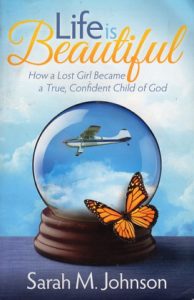Book Review: Life Is Beautiful by Sarah M. Johnson
In 2008, an airplane carrying humanitarian workers to a remote village in Guatemala, where they were to build a school, crashed and burned. The crew and most of the passengers were killed; one young woman survived relatively unharmed, though she had lost half her family, and her mother was severely injured. This is her story.
Sarah’s life had not been an easy one for some time before the crash. Raised outside a small town in rural Wisconsin, Sarah’s family was socially and emotionally isolated. Her father was a recovering meth addict, they’d recently lost a close relative to cancer, and what little social life Sarah had revolved around heavy drinking with her friends.
At college, Sarah met Jacob, a young man who introduced her to a stronger belief in God, but was dangerously flawed; in particular he reinforced her drinking habits. A combination of alcoholism and depression made Sarah’s college career a bust, and Jacob cheated on her, so she had to come home feeling a failure. The Guatemala trip was meant to help mend the family’s fences.
As this book is in the “inspirational” sub-genre, you might expect that Sarah turned her life around after hitting rock bottom, and you would be correct. When she finally accepted the help of a therapist (it isn’t directly stated, but her father’s apparent ability to quit meth cold turkey may have influenced her to try to handle everything solo), Sarah began to be able to process her grief and make progress on recovery from alcoholism. (Finding sober friends and a welcoming church group also helped.)
From a writing perspective, this book is a good example of how real people are far more complex and messy than they generally are shown in fiction. Jacob is a prime example, a fervent believer who introduces Sarah to a personal relationship with her “higher power” but prone to bouts of unwanted preaching and self-righteousness when drunk, and who is a toxic boyfriend for her.
One misstep is Sarah’s breakthrough moment with her therapist, when she can finally tell the story of the crash and its aftermath while allowing herself to feel the emotions associated with it. While it would be a powerful moment if the facts had been concealed up to that point in the book, on paper it’s mostly a recitation of details already covered in the first chapters. This is a short book, and a reader with a decent memory will find this bit redundant.
Recommended primarily to fans of inspirational literature, and older young adult readers who like non-fiction stories as Sarah’s life is of interest. Not necessarily recommended to those currently undergoing the grieving process; Sarah mentions several books that helped her, and those would probably be better choices.
If you would like to purchase the book, please consider getting it new, as part of the proceeds go to Habitat for Humanity.
Disclaimer: I received a free copy of this book to facilitate writing the review; no other compensation was offered or requested.

